中考英语知识点专项复习系列课件 专题05 非谓语动词(共33张PPT)
文档属性
| 名称 | 中考英语知识点专项复习系列课件 专题05 非谓语动词(共33张PPT) |  | |
| 格式 | zip | ||
| 文件大小 | 284.9KB | ||
| 资源类型 | 教案 | ||
| 版本资源 | 通用版 | ||
| 科目 | 英语 | ||
| 更新时间 | 2022-06-12 15:49:37 | ||
图片预览


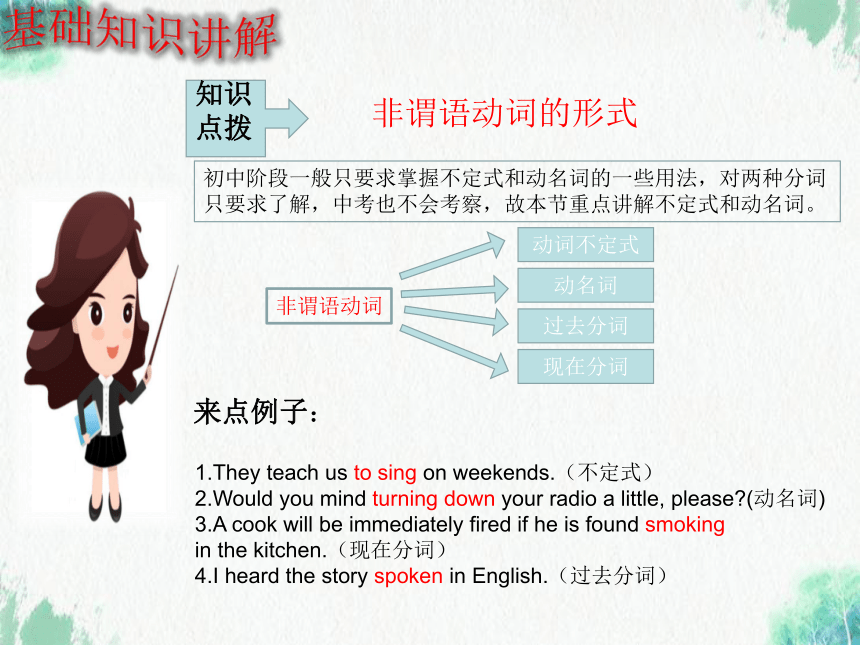




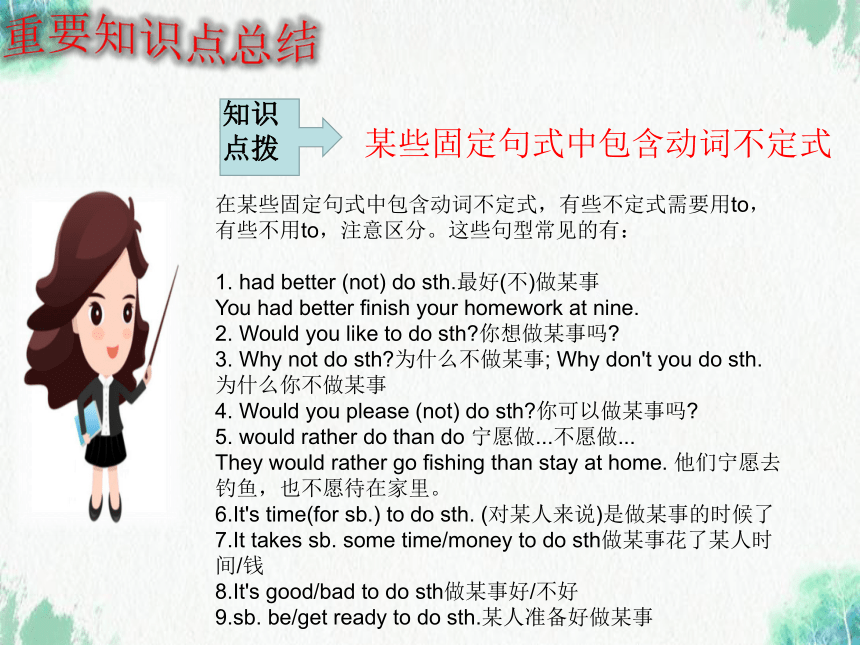
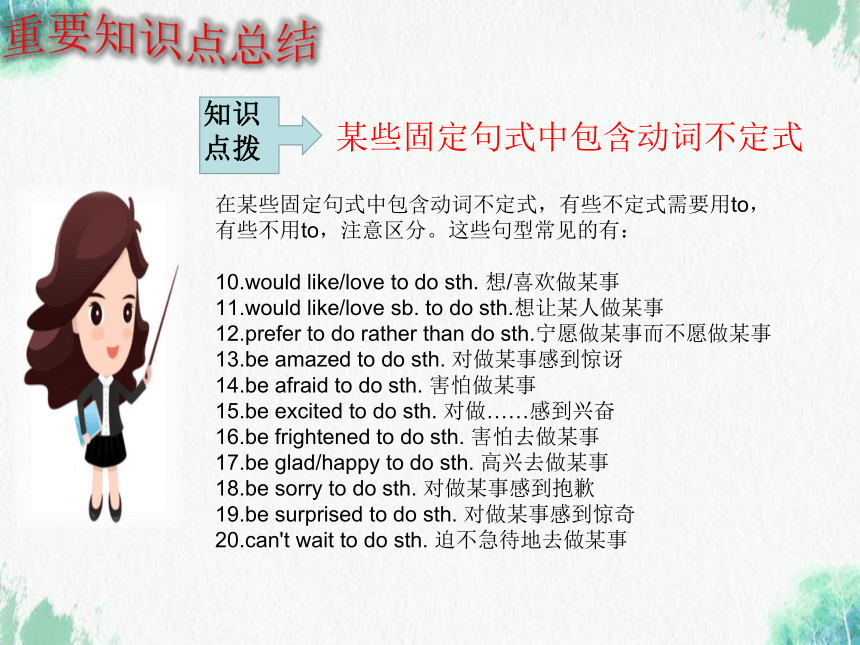
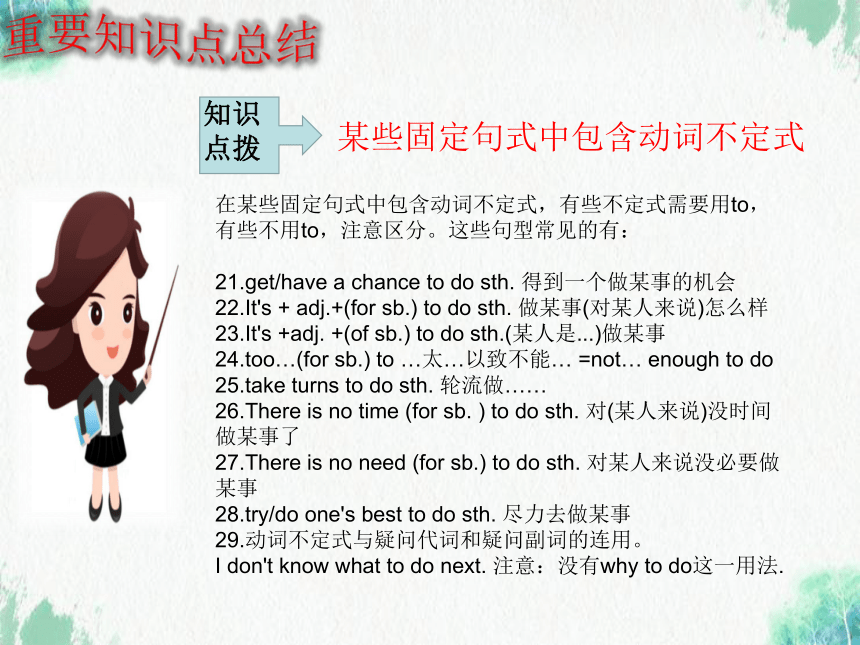
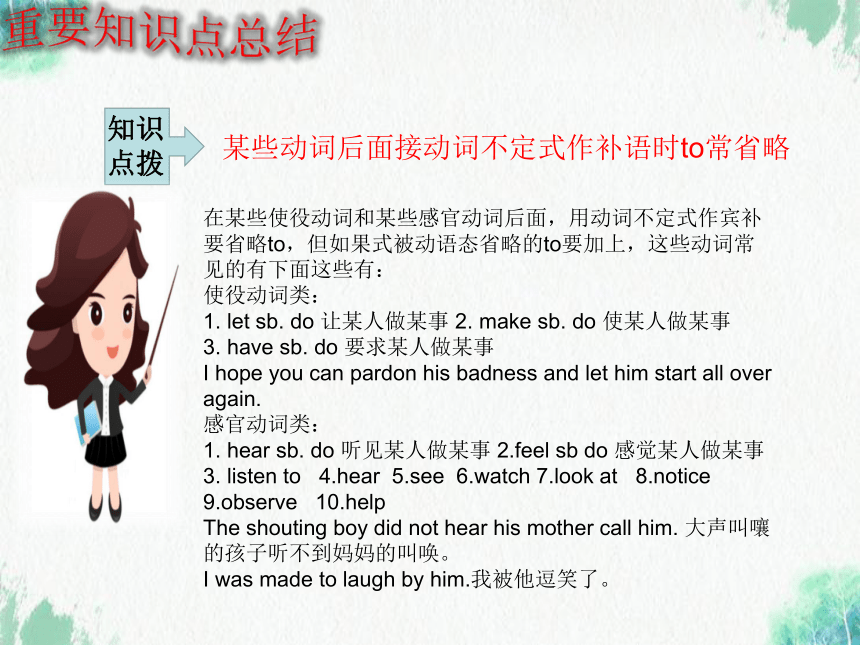
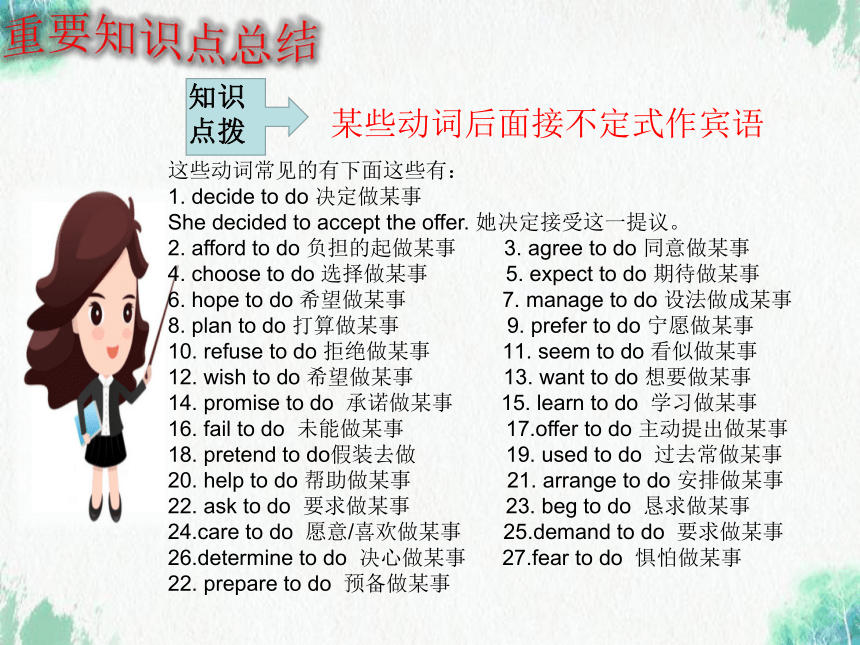
文档简介
(共33张PPT)
中考英语知识点专项复习系列课件
专题05 非谓语动词
知识
点拨
来点例子:
一个简单句中一般只能有一个谓语动词或动词短语(除非是用连词将谓语动词或短语并列),当已经存在一个主句(谓语动词),又没有连词的情况下,若还有其他动词要出现在句中,则只能使用该动词相应的非谓语形式来表达,否则句中的结构就是错的。
非谓语动词的概念
They teach us to sing on weekends.
句子中已经有了teach这个谓语动词后,还想表达“唱歌”这个
动作的意思时就不能直接用sing这样的谓语动词的形式,应该
用非谓语形式to sing(非谓语形式之一动词不定式)来表达该动
作,这里是不定式to sing作用时充当宾补。
基础知识讲解
知识
点拨
来点例子:
非谓语动词的形式
1.They teach us to sing on weekends.(不定式)
2.Would you mind turning down your radio a little, please (动名词)
3.A cook will be immediately fired if he is found smoking
in the kitchen.(现在分词)
4.I heard the story spoken in English.(过去分词)
非谓语动词
动词不定式
动名词
过去分词
现在分词
初中阶段一般只要求掌握不定式和动名词的一些用法,对两种分词只要求了解,中考也不会考察,故本节重点讲解不定式和动名词。
基础知识讲解
知识
点拨
动词不定式的主要用法
动词不定式是动词的非谓语形式之一,没有人称和数的变化,其形式为"to+动词原形",to为动词不定式的符号,本身无意义,在某些特殊情况下to可省略,动词不定式的否定形式就是在不定式之前加not,动词不定式具有动词的特点,因此,后面可以跟表语、宾语或状语,构成动词不定式短语,也具有名词、形容词或副词的特点,可以在句子中用作主语、宾语、宾语补足语、状语、定语、表语及同位语等,动词不定式还可以和疑问词连用,构成“疑问词+to do” 的用法,例如:
It is said that in Australia there is more land than the government knows what to do with it.
动词不定式肯定式:to read,否定直接not to read
基础知识讲解
知识
点拨
1、动词不定式作主语,如:
To learn a foreign language is not easy.
不定式复合结构作主语有时过长,为避免句子的头重脚轻,常用it作为形式主语,而真正的主语动词不定式后置,如:
It is not easy to learn a foreign language.
如要说明动作的执行者,可在不定式前加for或of引导,如果表语是描述动作执行者的性格、品质的形容词(nice, kind, clever等),用of引导, 其他的用for引导,如:
It's hard for us to learn English well.
动词不定式的主要用法讲解
基础知识讲解
知识
点拨:
2、动词不定式作宾语
一些动词常接动词不定式作宾语,如:
They began to read.
They happen to know the answer to the question.
当动词不定式作宾语时,后面如果还有宾语补足语,常用it作形式宾语,真正的宾语(不定式)放在宾语补足语之后,如:
I think it quite important to learn English well.
3、动词不定式作定语
动词不定式作后置定语时,与被修饰的名词逻辑上有动宾关系或介宾关系。当被修饰的名词如果不能直接作动词不定式的逻辑宾语则要带上与之搭配的介词,构成介宾关系,如:
I have an important meeting to attend.(动宾关系 to attend meeting)
I need a pen to write with. 我需要一支笔来写字。(介宾关系to write with a pen)
动词不定式的主要用法讲解
基础知识讲解
知识
点拨
4、动词不定式作宾语补足语
有些动词(tell, ask等)可接动词不定式作宾语补足语,构“动词 +sb.+ to do(有些用do) sth.结构。这一句型中宾语是动词不定式的逻辑主语。
We consider him to be a good teacher.(him是to be的逻辑主语)
She requested him to go with her. ( him是to go的逻辑主语)
5、动词不定式作状语
动词不定式作状语主要用来修饰动词,表示目的,结果或原因,如:He is sad to hear the bad news.他听到坏消息很伤心。(原因状语)
He studies hard to get good grades.他努力学习是为了取得好成绩。(目的状语)
The work is too hard for me to finish.完成那个工作对我来说太难了。(结果状语)
动词不定式的主要用法讲解
基础知识讲解
知识
点拨
在某些固定句式中包含动词不定式,有些不定式需要用to,有些不用to,注意区分。这些句型常见的有:
1. had better (not) do sth.最好(不)做某事
You had better finish your homework at nine.
2. Would you like to do sth 你想做某事吗
3. Why not do sth 为什么不做某事; Why don't you do sth.为什么你不做某事
4. Would you please (not) do sth 你可以做某事吗
5. would rather do than do 宁愿做...不愿做...
They would rather go fishing than stay at home. 他们宁愿去钓鱼,也不愿待在家里。
6.It's time(for sb.) to do sth. (对某人来说)是做某事的时候了
7.It takes sb. some time/money to do sth做某事花了某人时间/钱
8.It's good/bad to do sth做某事好/不好
9.sb. be/get ready to do sth.某人准备好做某事
某些固定句式中包含动词不定式
重要知识点总结
知识
点拨
在某些固定句式中包含动词不定式,有些不定式需要用to,有些不用to,注意区分。这些句型常见的有:
10.would like/love to do sth. 想/喜欢做某事
11.would like/love sb. to do sth.想让某人做某事
12.prefer to do rather than do sth.宁愿做某事而不愿做某事
13.be amazed to do sth. 对做某事感到惊讶
14.be afraid to do sth. 害怕做某事
15.be excited to do sth. 对做……感到兴奋
16.be frightened to do sth. 害怕去做某事
17.be glad/happy to do sth. 高兴去做某事
18.be sorry to do sth. 对做某事感到抱歉
19.be surprised to do sth. 对做某事感到惊奇
20.can't wait to do sth. 迫不急待地去做某事
某些固定句式中包含动词不定式
重要知识点总结
知识
点拨
在某些固定句式中包含动词不定式,有些不定式需要用to,有些不用to,注意区分。这些句型常见的有:
21.get/have a chance to do sth. 得到一个做某事的机会
22.It's + adj.+(for sb.) to do sth. 做某事(对某人来说)怎么样
23.It's +adj. +(of sb.) to do sth.(某人是...)做某事
24.too…(for sb.) to …太…以致不能… =not… enough to do
25.take turns to do sth. 轮流做……
26.There is no time (for sb. ) to do sth. 对(某人来说)没时间做某事了
27.There is no need (for sb.) to do sth. 对某人来说没必要做某事
28.try/do one's best to do sth. 尽力去做某事
29.动词不定式与疑问代词和疑问副词的连用。
I don't know what to do next. 注意:没有why to do这一用法.
某些固定句式中包含动词不定式
重要知识点总结
知识
点拨
某些动词后面接动词不定式作补语时to常省略
在某些使役动词和某些感官动词后面,用动词不定式作宾补要省略to,但如果式被动语态省略的to要加上,这些动词常见的有下面这些有:
使役动词类:
1. let sb. do 让某人做某事 2. make sb. do 使某人做某事
3. have sb. do 要求某人做某事
I hope you can pardon his badness and let him start all over again.
感官动词类:
1. hear sb. do 听见某人做某事 2.feel sb do 感觉某人做某事
3. listen to 4.hear 5.see 6.watch 7.look at 8.notice 9.observe 10.help
The shouting boy did not hear his mother call him. 大声叫嚷的孩子听不到妈妈的叫唤。
I was made to laugh by him.我被他逗笑了。
重要知识点总结
知识
点拨
某些动词后面接不定式作宾语
这些动词常见的有下面这些有:
1. decide to do 决定做某事
She decided to accept the offer. 她决定接受这一提议。
2. afford to do 负担的起做某事 3. agree to do 同意做某事
4. choose to do 选择做某事 5. expect to do 期待做某事
6. hope to do 希望做某事 7. manage to do 设法做成某事
8. plan to do 打算做某事 9. prefer to do 宁愿做某事
10. refuse to do 拒绝做某事 11. seem to do 看似做某事
12. wish to do 希望做某事 13. want to do 想要做某事
14. promise to do 承诺做某事 15. learn to do 学习做某事
16. fail to do 未能做某事 17.offer to do 主动提出做某事
18. pretend to do假装去做 19. used to do 过去常做某事
20. help to do 帮助做某事 21. arrange to do 安排做某事
22. ask to do 要求做某事 23. beg to do 恳求做某事
24.care to do 愿意/喜欢做某事 25.demand to do 要求做某事
26.determine to do 决心做某事 27.fear to do 惧怕做某事
22. prepare to do 预备做某事
重要知识点总结
知识
点拨
常见跟动词不定式作宾语补足语的动词
1. want sb. to do sth. 想要某人做某事
2. teach sb. to do sth. 教某人做某事
3. tell sb. to do sth. 告诉某人做某事
4. invite sb. to do sth. 邀请某人做某事
5. warn sb. to do sth. 警告某人做某事
6. ask sb. to do sth. 要求某人做某事
7. allow sb. to do sth. 允许某人做某事
8. advise sb. to do sth. 建议某人做某事
9. expect sb. to do sth. 期望某人做某事
10.remind sb. to do sth. 提醒某人做某事
重要知识点总结
知识
点拨
常见跟动词不定式作宾语补足语的动词
11.order sb. to do sth. 命令某人做某事
12.encourage sb. to do sth. 鼓励某人做某事
13.force sb. to do sth. 强迫某人做某事
14.follow sb. to do sth. 跟随某人去做某事
15.get sb. to do sth. 让某人做某事
16. bear sb. to do sth. 忍耐某人做某事
17. cause sb. to do sth. 导致某人做某事
18. hate sb. to do sth. 讨厌某人做某事
19. help sb. to do sth. 帮助某人做某事
20. like sb. to do sth. 喜欢某人做某事
21. need sb. to do sth. 需求某人做某事
22. prefer sb. to do sth. 宁愿某人做某事
23. train sb. to do sth. 训练某人做某事
重要知识点总结
知识
点拨
当一个动词被用作主语、宾语、补语或是同位语,也就是起名词作用时,需用其-ing 形成。这种既起名词作用又起动词作用的词称为动名词,动名词的否定直接在动名词前加not。
1. 作主语
Learning is important to modern life.
2. 作宾语
Would you mind turning down your radio a little, please 请问你介意调小一点收音机的音量吗
3. 作表语
Babysister’s job is washing,cooking and taking care of the children.保姆的工作是洗衣服,作饭和照看孩子。
4 作定语:可以作名词修饰语,说明名词的用途。
She is studying in the reading room.她在阅览室学习。
He slept in the sleeping bag. 他在睡袋里睡觉。
动名词的主要作用
基础知识讲解
知识
点拨
1. be good at/ do well in doing sth. 擅长做某事
2. pay attention to doing sth. 集中注意力做某事
3. what about/ how about doing sth做某事怎么样
4. thank you for doing sth. 感谢某人做某事
5.would you mind doing sth.你介意做吗
6. spend … (in) doing sth. 花费……做某时
7. make a contribution to doing sth. 在做某事上…作出了贡献
8. prefer doing sth. to doing sth. 喜欢做某事胜过了做某事
9. keep/ stop/ prevent sb. from doing sth. 阻止某人做某事10.look forward to doing 期望做某事
11.feel like doing sth.喜欢做某事
12.be busy doing sth.忙于做某事
13.be worth doing 值得做某事
14.have difficult/trouble in doing sth做某事有困难
15.give up doing sth.放弃做某事
某些短语若想接动词一般要用该动词的动名词形式
重要知识点总结
知识
点拨
16.be afraid of doing sth.害怕做某事
17.be interested in doing sth.对做某事感兴趣
18.be proud of doing sth.对做某事感到自豪
19.be fond of doing sth.喜爱做某事
20.be/get used to doing sth.习惯于做某事;
21. go+动名词,意思是去进行某种活动或运动:
go shopping去购物 go skating去滑冰
22. do some/the+动名词,指进行某种活动:
do some cleaning 打扫卫生 do some washing 洗衣服
某些短语若想接动词一般要用该动词的动名词形式
重要知识点总结
知识
点拨
practice doing sth. 练习做某事
I practice playing the piano twice a week.
finish doing sth.完成做某事 enjoy doing sth. 喜欢做某事practice doing sth. 练习做某事 imagine doing sth.想象做某事
avoid doing sth.避免做某事 consider doing sth.考虑做某事
suggest doing sth.建议做某事 mind doing sth.介意做某事
keep doing sth.持续做某事 miss doing sth.错过做,
advise doing sth.建议做 risk doing sth. 冒险做某事
admit doing sth. 承认做某事 allow doing sth. 允许做某事 appreciate doing sth. 感谢做某事 discuss doing sth. 讨论做某事 dislike doing sth. 不喜欢做某事 permit doing sth. 允许做某事 prohibit doing sth. 禁止做某事
常见的用动名词作宾语的动词
重要知识点总结
某些双宾动词,在运用“动词+sth+to+sb”这一句型时,省略sth或者sth太长放后面了,就形成了“动词+to+sb.”或者“动词+to+sb+sth”,注意to不能省略,例如:
describe to sb.向某人描述
explain to sb.向某人解释
express to sb.对某人表达
report to sb.向某报告
say to sb.向某告知
shout to sb.对某人大叫
suggest to sb.向某人提建议
speak to sb.对某人交谈
talk to sb.跟某人谈话,
例句:
She suggested to me one or two suitable people for the committee.她跟我向委员会推举了一两个合适的人选。
“动词+to+sb.”或者“动词+to+sb+sth”
知识
点拨
重要知识点总结
有些动词既可接不定式作宾语,又可接动名词作宾语
1. continue to do/doing sth(意义差别不大)持续、继续做某事
In spite of my effort to pacify it,the baby continue to cry/crying.
尽管我努力哄这婴儿,可他还是哭个不停
2.begin/start to do/doing sth(意义差别不大)开始做某事
We began learning / to learn English when we came to junior
middle school. 我们来初中学习时才开始学习英语。
3.forget(忘记),remember(记得),regret(后悔),这三个词:
① v+to do sth:表示不定式的动作发生于谓语动词的动作之后;
② v+doing sth:表示动名词的动作发生于谓语动词的动作之前。
remember to do sth记得要去做某事remember doing sth记得做过了某事
forget to do sth忘记了要去做某事forget doing sth忘记了做过某事
regret to do sth后悔了要去做某事 regret doing sth后悔了做过某事
I forgot to tell you about it. 我忘记要告诉你那件事了。
I remembered giving the book to Li Lei. 我记得我把书给Li Lei了。
知识
点拨
重要知识点总结
有些动词既可接不定式作宾语,又可接动名词作宾语
4. mean:
① mean to do sth:意思是:打算做,想要做;
② mean doing sth:意思是:意味着,意思是。
I didn’t mean to bother you. 我本不想打扰你。
What he said means going there by air. 他说话的意思是坐飞机去那儿。
5. try:
① try to do sth:意思是:设法做,尽力做;
② try doing sth:意思是:试着做。
I’ll try to catch up with my class this term. 这一学期我将尽力赶上同学们。
I tried reading the text without consulting my dictionary. 我试着不查词
典来阅读课文。
6. go on:
① go on to do sth:表示“接着做另一件事”
② go on doing sth:表示“继续做之前的事情,或间断后继续做原
来没有做完的事”。
7. stop
① stop to do sth:表示停下(手头的事情)去做另外一件事;
②stop doing sth:表示停止做某事,指停止做原来的事情。
知识
点拨
重要知识点总结
有些动词既可接不定式作宾语,又可接动名词作宾语
8. can’t help
① can’t help +(to)do,这里help就是帮助的意思“不能帮忙干…”
② can’t help +doing,这是固定短语,“情不自禁做…,禁不住做….”
I’m very busy now, so I can’t help (to) clean the room. 我现在很忙,
因此不能帮助打扫房间了。
The girl couldn’t help crying when she saw her mother again.
当小女孩再次看到母亲时,她情不自禁的哭了起来。
9. be used to
① be used to +do,这里就是use的被动语态,“被用作…”
② be used to +doing,这是固定短语,“习惯于做某事。”
The wood will be used to make paper. 这些木材将被用来造纸。
You will be used to living here soon. 你很快适应在这儿的生活。
知识
点拨
重要知识点总结
考点一:动词不定式的各种用法
考点二:动名词的各种用法
考点三:动词不定式和动名词作相同成分的区别
非谓语动词是中考常考的点,但是中考一般只考察不定式和动名词的用法,难度也不会很大,重点是记住本节所列的各种动词和不定式或者动名词的一起使用的情况,同时掌握和理解基础知识。
中考会怎么考?
考点分析和真题解析
分析一波考点
考点一:动词不定式考点
中考会怎么考?
主要的考察点:1. 动词不定式作主语
1.(甘肃中考真题改编) It's our duty _________ the room every day.
A. to clean B. cleaned C. clean
[答案] A
[简析]动词不定式作主语可以直接放在谓语动词前面,也可以用先行词it作形式主语,而将真正的主语(不定式)置于后面。这里to clean是
真正的主语。
2.(江西中考真题改编) It's hard for us _________ English well.
A. learn B. learns C. to learn
[答案] C
[简析]考察It is +形容词(for/of sb)to do sth句式,这里to learn是真正的主语,it作形式主语。
3. (安徽中考真题改编)It's very nice _________ you to get me two tickets _________ the World Cup.
A. for, of B. of, for C. to, for
[答案] B
[简析]在It is +形容词+(for/of sb) +to do sth句式中,如果形容词是表述不定式逻辑主语的属性或性质(nice, kind,clever,good等),介词常用of搭配,若表示不定式表示的动作、行为的性质(hard,difficult等),用
介词for搭配。
考点一:动词不定式考点
中考会怎么考?
1.(山西真题改编) He wants ______ some vegetables.
A. buy B. buying C. to buy
[答案] C
[简析]在want后面接不定式作宾语,故选C。
2.(福建真题改编) Don't forget ______ your homework with you when you come to school.
A. to bring B. bringing C. to take
[答案] A
[简析] 由when引导的时间状语从句知,不定式的动作还没有发生,故选A
3. (湖南真题改编)He found it very difficult ______.
A. sleeping B. sleeps C. to fall asleep
[答案] C
[简析]find如果其后接形容词补足语时,则可以用it作形式宾语,而把作真正宾语的不定式放到后面, to fall asleep 为真正宾语。
2.动词不定式作宾语
考点一:动词不定式考点
中考会怎么考?
1. (江苏真题改编)Robert often asks us ______ his Chinese, so his Chinese is much better than before.
A. help him B. to help him with C. to help with
[答案] B
[简析] ask后面可以接不定式作宾语补足语,help可以有自己的宾语,故选B。
2.(甘肃真题改编) Mr Li often teaches his Japanese friends ______ Chinese food.
A. cook B. cooks C. to cook
[答案] C
[简析]teach后面可以接不定式作宾语补足语,故选C。
3.动词不定式作宾语补语
考点一:动词不定式考点
中考会怎么考?
1.(江西真题改编) She went ______ her teacher.
A. to see B. looks C. saw
[答案] A
[简析]考察不定式作目的状语,故选A
2.(四川真题改编) Meimei likes English very much. She does her best ______ English well.
A. learn B. learning C. to learn
[答案] C
[简析]考察不定式作目的状语,故选A
3.(吉林真题改编) I'm sorry ______ you.
A. trouble B. to trouble C. troubling
[答案] B
[简析]考察不定式作原因状语,故选B
4.动词不定式作目的状语
考点一:动词不定式考点
中考会怎么考?
1.(湖北真题改编) Would you like something ______
A. drink B. drinking C. to drink
[答案] C
2.(河南真题改编) I have a lot of homework ______.
A. does B. doing C. did D. to do
[答案] D
3.(山东真题改编)He is not an easy man ______.
A. gets on B. to get on C. get on with D. to get on with
[答案] D
[简析]当不定式作定语时,常放在被修饰的词语之后,与被修饰的词语为逻辑上的主谓关系或动宾关系;如果不定式的动词是不及物动词,其后要加上必要的介词或副词,构成的短语动词相当于及物动词,所以上面三题的答案为CDD
5. 动词不定式作定语
考点一:动词不定式考点
中考会怎么考?
1.(河南真题改编) We saw him ______ the building and go upstairs.
A. to enter B. enter C. entering
[答案] B
[简析]在see, watch, hear, feel等感官动词后面作宾语补足语的不定式不带to。
2.(吉林真题改编) So much work usually makes them ______ very tired.
A. to feel B. feels C. feel
[答案] C
[简析]在make, have, let等使役动词后面作宾语补足语的不定式不带to。
3. (陕西真题改编) Your father is sleeping. You'd better ______.
A. not wake up him B. not to wake up him C. not wake him up
[答案] C
[简析]在"had better"后面接不带to的不定式
4.(贵州真题改编) I was made ______ my homework in the afternoon.
A. do B. doing C. to do
[答案] C
[简析]在一些感官动词和使役动词后面作宾语补足语的不定式不带to.但是在被动语态中,作主语补足语的不定式要带to。
7.不带to的动词不定式
考点一:动词不定式考点
中考会怎么考?
1.(青海真题改编) The new hospital ______ is near the factory.
A. build B. builds C. to be built
[答案] C
[简析]当不定式的逻辑主语是不定式所表示的动作的承受者(宾语)时,用动词不定式的被动式,即:to be +过去分词;如果不定式所表示的动作发生在谓语动词表示的动作之前,不定式用完成式,即:to have +过去分词;如果不定式表示的动作和谓语动词表示的动作同时发生,用不定式的进行式,即:to be +现在分词
8.动词不定式的被动式和其他形式
考点二:某些动词后面接不定式和
接动词-ing形式的区别
中考会怎么考?
1. (广西壮族自治区真题改编)Please stop ______ a rest if you feel tired.
A. to have B. having C. have
[答案] A
[简析] stop to do sth.意为"停止正在做的事情去做另外一件事",stop doing sth.意为"停止正在做的事",根据句意应选A
2. (湖北真题改编)——Why didn't you buy some bread on your way home
——Sorry, I forgot ______ some money with me.
A. take B. taking C. to take
[答案] C
[简析]forget to do sth.意为"忘了要做某事"(事还未做),forget doing sth.意为"忘了曾做过某事"(事已做),根据句意应选C。
3.(福建真题改编) When I was walking in the street I saw a plane ______ over my head.
A. flies B. flying C. flew
4.(黑龙江省) A woman saw it ______ when she was walking past.
A. happen B. happens C. happening
[答案] 3. B 4. A
[简析]在see, hear, watch, feel等感官动词后面可接不带to的不定式,也可接动词的-ing形式作宾语补足语,用不定式表示动作的全过程(动作已结束),用动词的-ing形式表示动作正在进行(动作尚未结束)。
考点三:动名词考点
中考会怎么考?
1.【2021·江苏苏州市·真题】During our holidays, we should avoid _____ up at night and oversleeping in the morning.
A. stay B. to stay C. stayed D. staying
【答案】D
【解析】avoid 后面接动名词作宾语。因此,正确答案是D
2.【2020·湖北孝感市·真题】When you are tired, _____ in the countryside is a wonderful experience.
A. relaxing B. relaxed C. relax D. relaxes
【答案】A
【解析】此题考查的是动名词作主语。句意:当你疲惫的时候,在乡下放松是很好的经历。relax 动词,放松;作主语用动名词。因此,正确答案是A
3.【2020·山东临沂市·真题】Most of us enjoy _____ to our mothers speak, because our brains greatly prefer the voices of our own mothers.
A. listening B. listen C. to listen
【答案】A
【解析】enjoy 后面接动名词作宾语。因此,正确答案是A
1.动名词作宾语 2.动名词作主语
That's all.Thank you!
中考英语知识点专项复习系列课件
专题05 非谓语动词
知识
点拨
来点例子:
一个简单句中一般只能有一个谓语动词或动词短语(除非是用连词将谓语动词或短语并列),当已经存在一个主句(谓语动词),又没有连词的情况下,若还有其他动词要出现在句中,则只能使用该动词相应的非谓语形式来表达,否则句中的结构就是错的。
非谓语动词的概念
They teach us to sing on weekends.
句子中已经有了teach这个谓语动词后,还想表达“唱歌”这个
动作的意思时就不能直接用sing这样的谓语动词的形式,应该
用非谓语形式to sing(非谓语形式之一动词不定式)来表达该动
作,这里是不定式to sing作用时充当宾补。
基础知识讲解
知识
点拨
来点例子:
非谓语动词的形式
1.They teach us to sing on weekends.(不定式)
2.Would you mind turning down your radio a little, please (动名词)
3.A cook will be immediately fired if he is found smoking
in the kitchen.(现在分词)
4.I heard the story spoken in English.(过去分词)
非谓语动词
动词不定式
动名词
过去分词
现在分词
初中阶段一般只要求掌握不定式和动名词的一些用法,对两种分词只要求了解,中考也不会考察,故本节重点讲解不定式和动名词。
基础知识讲解
知识
点拨
动词不定式的主要用法
动词不定式是动词的非谓语形式之一,没有人称和数的变化,其形式为"to+动词原形",to为动词不定式的符号,本身无意义,在某些特殊情况下to可省略,动词不定式的否定形式就是在不定式之前加not,动词不定式具有动词的特点,因此,后面可以跟表语、宾语或状语,构成动词不定式短语,也具有名词、形容词或副词的特点,可以在句子中用作主语、宾语、宾语补足语、状语、定语、表语及同位语等,动词不定式还可以和疑问词连用,构成“疑问词+to do” 的用法,例如:
It is said that in Australia there is more land than the government knows what to do with it.
动词不定式肯定式:to read,否定直接not to read
基础知识讲解
知识
点拨
1、动词不定式作主语,如:
To learn a foreign language is not easy.
不定式复合结构作主语有时过长,为避免句子的头重脚轻,常用it作为形式主语,而真正的主语动词不定式后置,如:
It is not easy to learn a foreign language.
如要说明动作的执行者,可在不定式前加for或of引导,如果表语是描述动作执行者的性格、品质的形容词(nice, kind, clever等),用of引导, 其他的用for引导,如:
It's hard for us to learn English well.
动词不定式的主要用法讲解
基础知识讲解
知识
点拨:
2、动词不定式作宾语
一些动词常接动词不定式作宾语,如:
They began to read.
They happen to know the answer to the question.
当动词不定式作宾语时,后面如果还有宾语补足语,常用it作形式宾语,真正的宾语(不定式)放在宾语补足语之后,如:
I think it quite important to learn English well.
3、动词不定式作定语
动词不定式作后置定语时,与被修饰的名词逻辑上有动宾关系或介宾关系。当被修饰的名词如果不能直接作动词不定式的逻辑宾语则要带上与之搭配的介词,构成介宾关系,如:
I have an important meeting to attend.(动宾关系 to attend meeting)
I need a pen to write with. 我需要一支笔来写字。(介宾关系to write with a pen)
动词不定式的主要用法讲解
基础知识讲解
知识
点拨
4、动词不定式作宾语补足语
有些动词(tell, ask等)可接动词不定式作宾语补足语,构“动词 +sb.+ to do(有些用do) sth.结构。这一句型中宾语是动词不定式的逻辑主语。
We consider him to be a good teacher.(him是to be的逻辑主语)
She requested him to go with her. ( him是to go的逻辑主语)
5、动词不定式作状语
动词不定式作状语主要用来修饰动词,表示目的,结果或原因,如:He is sad to hear the bad news.他听到坏消息很伤心。(原因状语)
He studies hard to get good grades.他努力学习是为了取得好成绩。(目的状语)
The work is too hard for me to finish.完成那个工作对我来说太难了。(结果状语)
动词不定式的主要用法讲解
基础知识讲解
知识
点拨
在某些固定句式中包含动词不定式,有些不定式需要用to,有些不用to,注意区分。这些句型常见的有:
1. had better (not) do sth.最好(不)做某事
You had better finish your homework at nine.
2. Would you like to do sth 你想做某事吗
3. Why not do sth 为什么不做某事; Why don't you do sth.为什么你不做某事
4. Would you please (not) do sth 你可以做某事吗
5. would rather do than do 宁愿做...不愿做...
They would rather go fishing than stay at home. 他们宁愿去钓鱼,也不愿待在家里。
6.It's time(for sb.) to do sth. (对某人来说)是做某事的时候了
7.It takes sb. some time/money to do sth做某事花了某人时间/钱
8.It's good/bad to do sth做某事好/不好
9.sb. be/get ready to do sth.某人准备好做某事
某些固定句式中包含动词不定式
重要知识点总结
知识
点拨
在某些固定句式中包含动词不定式,有些不定式需要用to,有些不用to,注意区分。这些句型常见的有:
10.would like/love to do sth. 想/喜欢做某事
11.would like/love sb. to do sth.想让某人做某事
12.prefer to do rather than do sth.宁愿做某事而不愿做某事
13.be amazed to do sth. 对做某事感到惊讶
14.be afraid to do sth. 害怕做某事
15.be excited to do sth. 对做……感到兴奋
16.be frightened to do sth. 害怕去做某事
17.be glad/happy to do sth. 高兴去做某事
18.be sorry to do sth. 对做某事感到抱歉
19.be surprised to do sth. 对做某事感到惊奇
20.can't wait to do sth. 迫不急待地去做某事
某些固定句式中包含动词不定式
重要知识点总结
知识
点拨
在某些固定句式中包含动词不定式,有些不定式需要用to,有些不用to,注意区分。这些句型常见的有:
21.get/have a chance to do sth. 得到一个做某事的机会
22.It's + adj.+(for sb.) to do sth. 做某事(对某人来说)怎么样
23.It's +adj. +(of sb.) to do sth.(某人是...)做某事
24.too…(for sb.) to …太…以致不能… =not… enough to do
25.take turns to do sth. 轮流做……
26.There is no time (for sb. ) to do sth. 对(某人来说)没时间做某事了
27.There is no need (for sb.) to do sth. 对某人来说没必要做某事
28.try/do one's best to do sth. 尽力去做某事
29.动词不定式与疑问代词和疑问副词的连用。
I don't know what to do next. 注意:没有why to do这一用法.
某些固定句式中包含动词不定式
重要知识点总结
知识
点拨
某些动词后面接动词不定式作补语时to常省略
在某些使役动词和某些感官动词后面,用动词不定式作宾补要省略to,但如果式被动语态省略的to要加上,这些动词常见的有下面这些有:
使役动词类:
1. let sb. do 让某人做某事 2. make sb. do 使某人做某事
3. have sb. do 要求某人做某事
I hope you can pardon his badness and let him start all over again.
感官动词类:
1. hear sb. do 听见某人做某事 2.feel sb do 感觉某人做某事
3. listen to 4.hear 5.see 6.watch 7.look at 8.notice 9.observe 10.help
The shouting boy did not hear his mother call him. 大声叫嚷的孩子听不到妈妈的叫唤。
I was made to laugh by him.我被他逗笑了。
重要知识点总结
知识
点拨
某些动词后面接不定式作宾语
这些动词常见的有下面这些有:
1. decide to do 决定做某事
She decided to accept the offer. 她决定接受这一提议。
2. afford to do 负担的起做某事 3. agree to do 同意做某事
4. choose to do 选择做某事 5. expect to do 期待做某事
6. hope to do 希望做某事 7. manage to do 设法做成某事
8. plan to do 打算做某事 9. prefer to do 宁愿做某事
10. refuse to do 拒绝做某事 11. seem to do 看似做某事
12. wish to do 希望做某事 13. want to do 想要做某事
14. promise to do 承诺做某事 15. learn to do 学习做某事
16. fail to do 未能做某事 17.offer to do 主动提出做某事
18. pretend to do假装去做 19. used to do 过去常做某事
20. help to do 帮助做某事 21. arrange to do 安排做某事
22. ask to do 要求做某事 23. beg to do 恳求做某事
24.care to do 愿意/喜欢做某事 25.demand to do 要求做某事
26.determine to do 决心做某事 27.fear to do 惧怕做某事
22. prepare to do 预备做某事
重要知识点总结
知识
点拨
常见跟动词不定式作宾语补足语的动词
1. want sb. to do sth. 想要某人做某事
2. teach sb. to do sth. 教某人做某事
3. tell sb. to do sth. 告诉某人做某事
4. invite sb. to do sth. 邀请某人做某事
5. warn sb. to do sth. 警告某人做某事
6. ask sb. to do sth. 要求某人做某事
7. allow sb. to do sth. 允许某人做某事
8. advise sb. to do sth. 建议某人做某事
9. expect sb. to do sth. 期望某人做某事
10.remind sb. to do sth. 提醒某人做某事
重要知识点总结
知识
点拨
常见跟动词不定式作宾语补足语的动词
11.order sb. to do sth. 命令某人做某事
12.encourage sb. to do sth. 鼓励某人做某事
13.force sb. to do sth. 强迫某人做某事
14.follow sb. to do sth. 跟随某人去做某事
15.get sb. to do sth. 让某人做某事
16. bear sb. to do sth. 忍耐某人做某事
17. cause sb. to do sth. 导致某人做某事
18. hate sb. to do sth. 讨厌某人做某事
19. help sb. to do sth. 帮助某人做某事
20. like sb. to do sth. 喜欢某人做某事
21. need sb. to do sth. 需求某人做某事
22. prefer sb. to do sth. 宁愿某人做某事
23. train sb. to do sth. 训练某人做某事
重要知识点总结
知识
点拨
当一个动词被用作主语、宾语、补语或是同位语,也就是起名词作用时,需用其-ing 形成。这种既起名词作用又起动词作用的词称为动名词,动名词的否定直接在动名词前加not。
1. 作主语
Learning is important to modern life.
2. 作宾语
Would you mind turning down your radio a little, please 请问你介意调小一点收音机的音量吗
3. 作表语
Babysister’s job is washing,cooking and taking care of the children.保姆的工作是洗衣服,作饭和照看孩子。
4 作定语:可以作名词修饰语,说明名词的用途。
She is studying in the reading room.她在阅览室学习。
He slept in the sleeping bag. 他在睡袋里睡觉。
动名词的主要作用
基础知识讲解
知识
点拨
1. be good at/ do well in doing sth. 擅长做某事
2. pay attention to doing sth. 集中注意力做某事
3. what about/ how about doing sth做某事怎么样
4. thank you for doing sth. 感谢某人做某事
5.would you mind doing sth.你介意做吗
6. spend … (in) doing sth. 花费……做某时
7. make a contribution to doing sth. 在做某事上…作出了贡献
8. prefer doing sth. to doing sth. 喜欢做某事胜过了做某事
9. keep/ stop/ prevent sb. from doing sth. 阻止某人做某事10.look forward to doing 期望做某事
11.feel like doing sth.喜欢做某事
12.be busy doing sth.忙于做某事
13.be worth doing 值得做某事
14.have difficult/trouble in doing sth做某事有困难
15.give up doing sth.放弃做某事
某些短语若想接动词一般要用该动词的动名词形式
重要知识点总结
知识
点拨
16.be afraid of doing sth.害怕做某事
17.be interested in doing sth.对做某事感兴趣
18.be proud of doing sth.对做某事感到自豪
19.be fond of doing sth.喜爱做某事
20.be/get used to doing sth.习惯于做某事;
21. go+动名词,意思是去进行某种活动或运动:
go shopping去购物 go skating去滑冰
22. do some/the+动名词,指进行某种活动:
do some cleaning 打扫卫生 do some washing 洗衣服
某些短语若想接动词一般要用该动词的动名词形式
重要知识点总结
知识
点拨
practice doing sth. 练习做某事
I practice playing the piano twice a week.
finish doing sth.完成做某事 enjoy doing sth. 喜欢做某事practice doing sth. 练习做某事 imagine doing sth.想象做某事
avoid doing sth.避免做某事 consider doing sth.考虑做某事
suggest doing sth.建议做某事 mind doing sth.介意做某事
keep doing sth.持续做某事 miss doing sth.错过做,
advise doing sth.建议做 risk doing sth. 冒险做某事
admit doing sth. 承认做某事 allow doing sth. 允许做某事 appreciate doing sth. 感谢做某事 discuss doing sth. 讨论做某事 dislike doing sth. 不喜欢做某事 permit doing sth. 允许做某事 prohibit doing sth. 禁止做某事
常见的用动名词作宾语的动词
重要知识点总结
某些双宾动词,在运用“动词+sth+to+sb”这一句型时,省略sth或者sth太长放后面了,就形成了“动词+to+sb.”或者“动词+to+sb+sth”,注意to不能省略,例如:
describe to sb.向某人描述
explain to sb.向某人解释
express to sb.对某人表达
report to sb.向某报告
say to sb.向某告知
shout to sb.对某人大叫
suggest to sb.向某人提建议
speak to sb.对某人交谈
talk to sb.跟某人谈话,
例句:
She suggested to me one or two suitable people for the committee.她跟我向委员会推举了一两个合适的人选。
“动词+to+sb.”或者“动词+to+sb+sth”
知识
点拨
重要知识点总结
有些动词既可接不定式作宾语,又可接动名词作宾语
1. continue to do/doing sth(意义差别不大)持续、继续做某事
In spite of my effort to pacify it,the baby continue to cry/crying.
尽管我努力哄这婴儿,可他还是哭个不停
2.begin/start to do/doing sth(意义差别不大)开始做某事
We began learning / to learn English when we came to junior
middle school. 我们来初中学习时才开始学习英语。
3.forget(忘记),remember(记得),regret(后悔),这三个词:
① v+to do sth:表示不定式的动作发生于谓语动词的动作之后;
② v+doing sth:表示动名词的动作发生于谓语动词的动作之前。
remember to do sth记得要去做某事remember doing sth记得做过了某事
forget to do sth忘记了要去做某事forget doing sth忘记了做过某事
regret to do sth后悔了要去做某事 regret doing sth后悔了做过某事
I forgot to tell you about it. 我忘记要告诉你那件事了。
I remembered giving the book to Li Lei. 我记得我把书给Li Lei了。
知识
点拨
重要知识点总结
有些动词既可接不定式作宾语,又可接动名词作宾语
4. mean:
① mean to do sth:意思是:打算做,想要做;
② mean doing sth:意思是:意味着,意思是。
I didn’t mean to bother you. 我本不想打扰你。
What he said means going there by air. 他说话的意思是坐飞机去那儿。
5. try:
① try to do sth:意思是:设法做,尽力做;
② try doing sth:意思是:试着做。
I’ll try to catch up with my class this term. 这一学期我将尽力赶上同学们。
I tried reading the text without consulting my dictionary. 我试着不查词
典来阅读课文。
6. go on:
① go on to do sth:表示“接着做另一件事”
② go on doing sth:表示“继续做之前的事情,或间断后继续做原
来没有做完的事”。
7. stop
① stop to do sth:表示停下(手头的事情)去做另外一件事;
②stop doing sth:表示停止做某事,指停止做原来的事情。
知识
点拨
重要知识点总结
有些动词既可接不定式作宾语,又可接动名词作宾语
8. can’t help
① can’t help +(to)do,这里help就是帮助的意思“不能帮忙干…”
② can’t help +doing,这是固定短语,“情不自禁做…,禁不住做….”
I’m very busy now, so I can’t help (to) clean the room. 我现在很忙,
因此不能帮助打扫房间了。
The girl couldn’t help crying when she saw her mother again.
当小女孩再次看到母亲时,她情不自禁的哭了起来。
9. be used to
① be used to +do,这里就是use的被动语态,“被用作…”
② be used to +doing,这是固定短语,“习惯于做某事。”
The wood will be used to make paper. 这些木材将被用来造纸。
You will be used to living here soon. 你很快适应在这儿的生活。
知识
点拨
重要知识点总结
考点一:动词不定式的各种用法
考点二:动名词的各种用法
考点三:动词不定式和动名词作相同成分的区别
非谓语动词是中考常考的点,但是中考一般只考察不定式和动名词的用法,难度也不会很大,重点是记住本节所列的各种动词和不定式或者动名词的一起使用的情况,同时掌握和理解基础知识。
中考会怎么考?
考点分析和真题解析
分析一波考点
考点一:动词不定式考点
中考会怎么考?
主要的考察点:1. 动词不定式作主语
1.(甘肃中考真题改编) It's our duty _________ the room every day.
A. to clean B. cleaned C. clean
[答案] A
[简析]动词不定式作主语可以直接放在谓语动词前面,也可以用先行词it作形式主语,而将真正的主语(不定式)置于后面。这里to clean是
真正的主语。
2.(江西中考真题改编) It's hard for us _________ English well.
A. learn B. learns C. to learn
[答案] C
[简析]考察It is +形容词(for/of sb)to do sth句式,这里to learn是真正的主语,it作形式主语。
3. (安徽中考真题改编)It's very nice _________ you to get me two tickets _________ the World Cup.
A. for, of B. of, for C. to, for
[答案] B
[简析]在It is +形容词+(for/of sb) +to do sth句式中,如果形容词是表述不定式逻辑主语的属性或性质(nice, kind,clever,good等),介词常用of搭配,若表示不定式表示的动作、行为的性质(hard,difficult等),用
介词for搭配。
考点一:动词不定式考点
中考会怎么考?
1.(山西真题改编) He wants ______ some vegetables.
A. buy B. buying C. to buy
[答案] C
[简析]在want后面接不定式作宾语,故选C。
2.(福建真题改编) Don't forget ______ your homework with you when you come to school.
A. to bring B. bringing C. to take
[答案] A
[简析] 由when引导的时间状语从句知,不定式的动作还没有发生,故选A
3. (湖南真题改编)He found it very difficult ______.
A. sleeping B. sleeps C. to fall asleep
[答案] C
[简析]find如果其后接形容词补足语时,则可以用it作形式宾语,而把作真正宾语的不定式放到后面, to fall asleep 为真正宾语。
2.动词不定式作宾语
考点一:动词不定式考点
中考会怎么考?
1. (江苏真题改编)Robert often asks us ______ his Chinese, so his Chinese is much better than before.
A. help him B. to help him with C. to help with
[答案] B
[简析] ask后面可以接不定式作宾语补足语,help可以有自己的宾语,故选B。
2.(甘肃真题改编) Mr Li often teaches his Japanese friends ______ Chinese food.
A. cook B. cooks C. to cook
[答案] C
[简析]teach后面可以接不定式作宾语补足语,故选C。
3.动词不定式作宾语补语
考点一:动词不定式考点
中考会怎么考?
1.(江西真题改编) She went ______ her teacher.
A. to see B. looks C. saw
[答案] A
[简析]考察不定式作目的状语,故选A
2.(四川真题改编) Meimei likes English very much. She does her best ______ English well.
A. learn B. learning C. to learn
[答案] C
[简析]考察不定式作目的状语,故选A
3.(吉林真题改编) I'm sorry ______ you.
A. trouble B. to trouble C. troubling
[答案] B
[简析]考察不定式作原因状语,故选B
4.动词不定式作目的状语
考点一:动词不定式考点
中考会怎么考?
1.(湖北真题改编) Would you like something ______
A. drink B. drinking C. to drink
[答案] C
2.(河南真题改编) I have a lot of homework ______.
A. does B. doing C. did D. to do
[答案] D
3.(山东真题改编)He is not an easy man ______.
A. gets on B. to get on C. get on with D. to get on with
[答案] D
[简析]当不定式作定语时,常放在被修饰的词语之后,与被修饰的词语为逻辑上的主谓关系或动宾关系;如果不定式的动词是不及物动词,其后要加上必要的介词或副词,构成的短语动词相当于及物动词,所以上面三题的答案为CDD
5. 动词不定式作定语
考点一:动词不定式考点
中考会怎么考?
1.(河南真题改编) We saw him ______ the building and go upstairs.
A. to enter B. enter C. entering
[答案] B
[简析]在see, watch, hear, feel等感官动词后面作宾语补足语的不定式不带to。
2.(吉林真题改编) So much work usually makes them ______ very tired.
A. to feel B. feels C. feel
[答案] C
[简析]在make, have, let等使役动词后面作宾语补足语的不定式不带to。
3. (陕西真题改编) Your father is sleeping. You'd better ______.
A. not wake up him B. not to wake up him C. not wake him up
[答案] C
[简析]在"had better"后面接不带to的不定式
4.(贵州真题改编) I was made ______ my homework in the afternoon.
A. do B. doing C. to do
[答案] C
[简析]在一些感官动词和使役动词后面作宾语补足语的不定式不带to.但是在被动语态中,作主语补足语的不定式要带to。
7.不带to的动词不定式
考点一:动词不定式考点
中考会怎么考?
1.(青海真题改编) The new hospital ______ is near the factory.
A. build B. builds C. to be built
[答案] C
[简析]当不定式的逻辑主语是不定式所表示的动作的承受者(宾语)时,用动词不定式的被动式,即:to be +过去分词;如果不定式所表示的动作发生在谓语动词表示的动作之前,不定式用完成式,即:to have +过去分词;如果不定式表示的动作和谓语动词表示的动作同时发生,用不定式的进行式,即:to be +现在分词
8.动词不定式的被动式和其他形式
考点二:某些动词后面接不定式和
接动词-ing形式的区别
中考会怎么考?
1. (广西壮族自治区真题改编)Please stop ______ a rest if you feel tired.
A. to have B. having C. have
[答案] A
[简析] stop to do sth.意为"停止正在做的事情去做另外一件事",stop doing sth.意为"停止正在做的事",根据句意应选A
2. (湖北真题改编)——Why didn't you buy some bread on your way home
——Sorry, I forgot ______ some money with me.
A. take B. taking C. to take
[答案] C
[简析]forget to do sth.意为"忘了要做某事"(事还未做),forget doing sth.意为"忘了曾做过某事"(事已做),根据句意应选C。
3.(福建真题改编) When I was walking in the street I saw a plane ______ over my head.
A. flies B. flying C. flew
4.(黑龙江省) A woman saw it ______ when she was walking past.
A. happen B. happens C. happening
[答案] 3. B 4. A
[简析]在see, hear, watch, feel等感官动词后面可接不带to的不定式,也可接动词的-ing形式作宾语补足语,用不定式表示动作的全过程(动作已结束),用动词的-ing形式表示动作正在进行(动作尚未结束)。
考点三:动名词考点
中考会怎么考?
1.【2021·江苏苏州市·真题】During our holidays, we should avoid _____ up at night and oversleeping in the morning.
A. stay B. to stay C. stayed D. staying
【答案】D
【解析】avoid 后面接动名词作宾语。因此,正确答案是D
2.【2020·湖北孝感市·真题】When you are tired, _____ in the countryside is a wonderful experience.
A. relaxing B. relaxed C. relax D. relaxes
【答案】A
【解析】此题考查的是动名词作主语。句意:当你疲惫的时候,在乡下放松是很好的经历。relax 动词,放松;作主语用动名词。因此,正确答案是A
3.【2020·山东临沂市·真题】Most of us enjoy _____ to our mothers speak, because our brains greatly prefer the voices of our own mothers.
A. listening B. listen C. to listen
【答案】A
【解析】enjoy 后面接动名词作宾语。因此,正确答案是A
1.动名词作宾语 2.动名词作主语
That's all.Thank you!
同课章节目录
- 词法
- 名词
- 动词和动词短语
- 动词语态
- 动词时态
- 助动词和情态动词
- 非谓语动词
- 冠词
- 代词
- 数词和量词
- 形容词副词及其比较等级
- 介词和介词短语
- 连词和感叹词
- 构词法
- 相似、相近词比较
- 句法
- 陈述句
- 一般疑问句和否定疑问句
- 特殊疑问句及选择疑问句
- 反意疑问句
- 存在句(There be句型)
- 宾语从句
- 定语从句
- 状语从句
- 主谓一致问题
- 简单句
- 并列句
- 复合句
- 主谓一致
- 主、表语从句
- 名词性从句
- 直接引语和间接引语
- 虚拟语气
- 感叹句
- 强调句
- 倒装句
- 祈使句
- 句子的成分
- 句子的分类
- 题型专区
- 单项选择部分
- 易错题
- 完形填空
- 阅读理解
- 词汇练习
- 听说训练
- 句型转换
- 补全对话
- 短文改错
- 翻译
- 书面表达
- 任务型阅读
- 语法填空
- 其他资料
